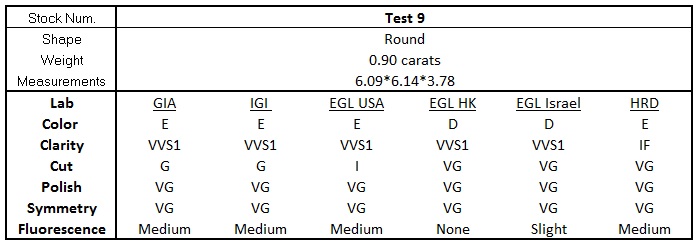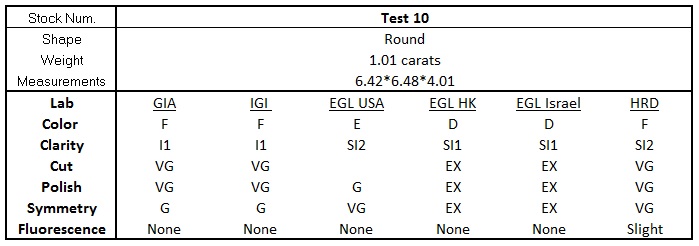No two diamonds are alike and it seems neither are their grading certificates. A survey by RapNet – the Rapaport Diamond Trading Network, found significant differences between laboratories grading the same diamond.
While there is a common language used in the grading of diamonds, there are clear inconsistencies in the use of that language, concluded Saville Stern, chief operating officer of RapNet. Stern oversaw the study and presented its findings at the fourth annual Rapaport Diamond Certification Conference in Las Vegas on June 2. (View the full panel discussion here).
The RapNet team sent 10 diamonds, ranging in size from 0.33 carat to 1.62 carats, and of varying qualities to six different labs for grading to assess the consistency, or lack thereof, of their respective reports. The diamonds were sent to the GIA, IGI, HRD, EGL USA, EGL Israel and EGL Hong Kong.
The results were analyzed according to the strictness of grading and the price those goods would achieve on RapNet. The survey is a precursor to a more in-depth study currently being conducted by RapNet.
While the results on some of the sample diamonds indicated some consistency in grading, there were significant variations on others. (See the full results in the tables at the end of this article).
Typically, one color or clarity grade variation would be considered reasonably acceptable in the market. On some of the diamonds, the labs were fairly consistent providing only slight variations in color and clarity.
More dramatic differences were apparent in other stones. For example, a 1.01 carat stone was graded as K color, SI1 clarity by both GIA and IGI, whereas EGL Israel graded it a G, VS1, a difference of 4 color grades and 2 clarity grades. A different 1.01 carat diamond was found to be F, I1 by GIA and IGI, but was graded as D, SI1 by EGL Israel and EGL Hong Kong, while HRD graded it to be F, SI2.
RapNet gathered the data from the grading reports provided by each of the labs on each of the respective diamonds to present its Laboratory Quality Index as a means to indicate which labs are more lenient and which are stricter than others.
The method used was to assign a number to each score of the color, clarity, polish, symmetry, cut, and fluorescence categories graded by the particular lab for every stone, whereby the lower number assigned, the more strict the grading. For example, regarding color, K being the strictest grade was assigned the numeric value of one, while D color was assigned the value eight. Similarly, a SI3 clarity – the lowest clarity for the survey’s purpose representing the strictest grade – was given a value of one and the respective better clarities above it scaled up until IF was given a value of eight.
The values were totaled for every stone for each lab to indicate its level of lenience or strictness. The totals for the sample 10 stones were averaged for each lab, leading to the Laboratory Quality Index, as presented in Table 1 and Table 2 below.

Table 1
According to the index, the lower the score, the more strict the lab. The survey therefore ranks the GIA as the strictest of the labs, followed very closely by IGI and EGL USA. The scores of these three labs were sufficiently close to suggest that the U.S.-based labs are working within comparable boundaries, while the non-U.S. labs are applying more lenient standards. Whereas HRD is treading a fine line in its grading quality, EGL Hong Kong and EGL Israel were by far the most lenient of the labs that were surveyed.
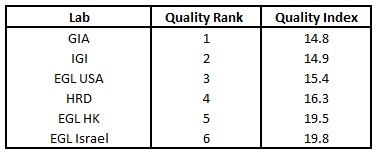
Table 2
Stern suggested that the differences in quality of grading might already be factored into the manner in which the market prices the diamonds from each lab. A stone with certain parameters given by a lenient lab might demand a higher discount than a stone with the same parameters given by a stricter lab. However, the survey found that while there are differences in prices that the various labs garner, they are not sufficient to substantiate the large differences in grading.
Rather, the survey suggested that while the labs have different reputations, as reflected in the prices they garner, sometimes that reputation is not equally reflected in the quality of their grading.
To assess the price ranking of the various labs, the RapNet team took each of the diamonds graded in the survey, and searched for diamonds with similar parameters by the same lab on RapNet. So for each of the diamonds, the survey checked the average price that similar diamonds were selling for on RapNet and averaged the results. The findings suggest which lab would have given the highest price for that specific diamond, based on the parameters given by each of the labs for diamonds found on RapNet.
According to the survey, selling all of the diamonds corresponding to each lab’s respective standards would have brought in the total revenues listed in Table 3 below, indicating which of the labs gain the highest prices for the same set of diamonds in the market. (Some diamonds were excluded from this test due to insufficient RapNet data existing to base a conclusion).
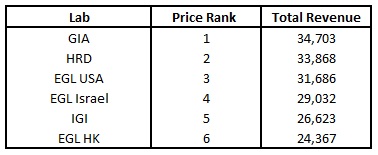
Table 3
The GIA gained the highest price ranking, followed by HRD, EGL USA, EGL Israel, IGI and EGL Hong Kong respectively.
The survey showed some surprising results when comparing price with quality of grading by the different labs (as presented in Table 2 and Table 3 above). It appears that some labs – such as IGI, which ranks second in the Laboratory Quality Index but fifth in the price ranking – are being punished in their pricing and that their diamonds are selling for less than what their grading standard deserves. In contrast, HRD graded stones seem to get a better price than their grading warrants as the lab is listed second in the price ranking but only fourth in the quality index.
Selling diamonds not certificates
When it comes to grading diamonds, certificates are used in different ways for different members of the industry. Stern notes, for example, that diamond manufacturers use certs to assist in their pricing and marketing of the diamonds they’re selling. A dealer may use them differently and even chose a lab based on his ability to sell the diamond – factoring in the type of diamond being sold and which market is targeted – rather than choosing a lab for its grading quality. Certs are also used by insurance companies when determining the replacement value of a stone that may have been lost or stolen.
However, it’s at the retail level that the industry stands to lose the most from the labs’ inconsistent grading standards. How does a jewelry retailer explain these differences to a customer? Particularly in today’s information age, retailers increasingly have to explain to customers why a diamond viewed online with certain specifications is not the same price as a diamond in his/her store with the same grading done by a stricter lab. How can the industry expect the consumer to understand that the same diamond can be given an H color by one lab and K color by another, or VS2 clarity versus SI1?
The survey presents more questions than answers. While many have called for greater regulation of the labs, they’re unsure how that would work. What is clear is that jewelry retailers are left to convince customers to trust them more than their certificates. Stern challenged retailers to stand behind the products they’re selling.
Jewelers need to focus on selling diamonds rather than certs to ensure consumer confidence in the industry. And the same applies to the rest of the diamond and jewelry pipeline. For the industry to really achieve its goal to encourage and grow diamond consumption, manufacturers and dealers too, need to focus on selling their expertise and their product. After all, diamond certificates are intended as a vital tool to aide in that very process.
The following are the results of the grading of each diamond by the respective laboratories:
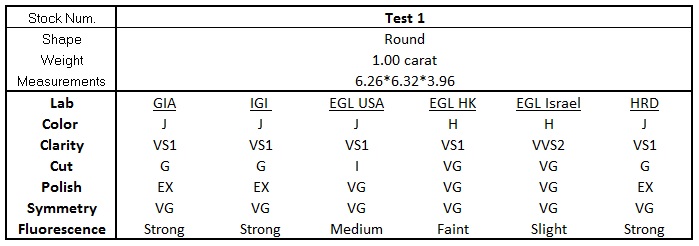
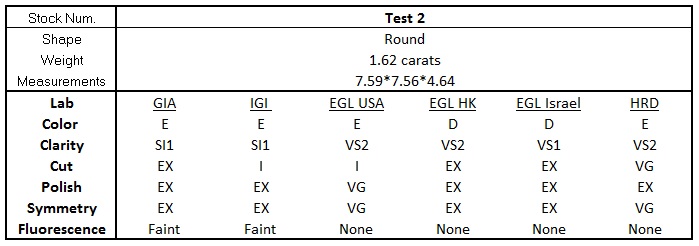
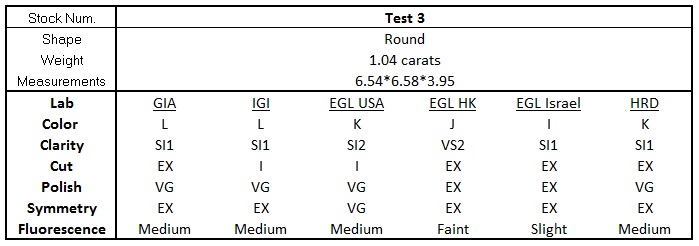
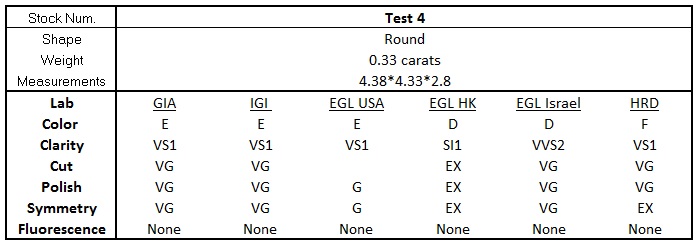
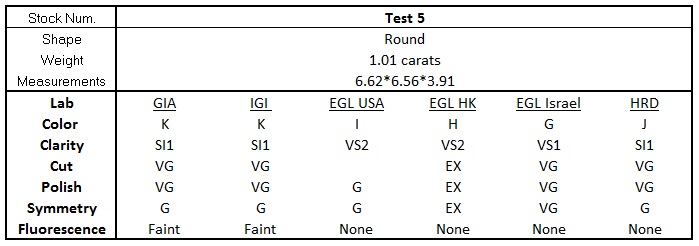
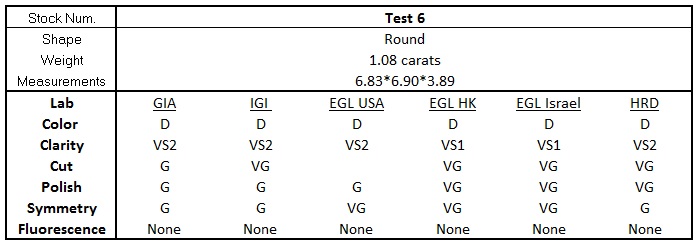
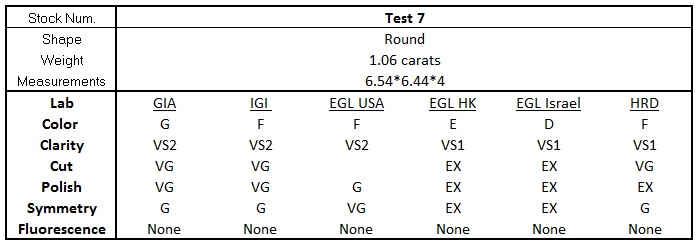
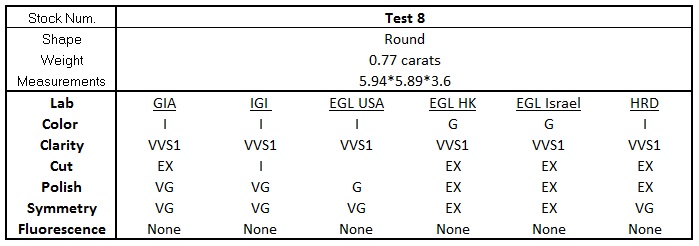
>